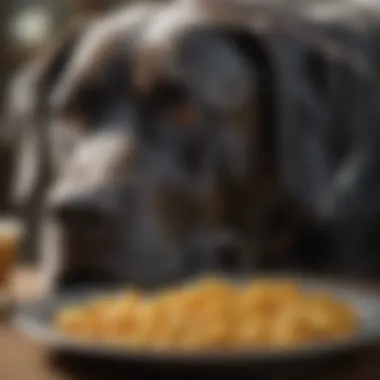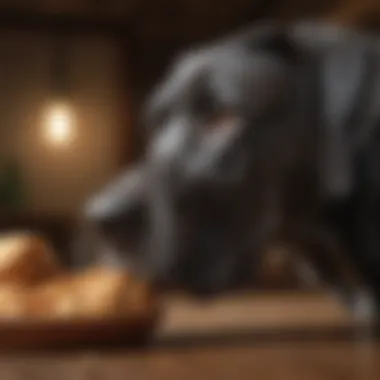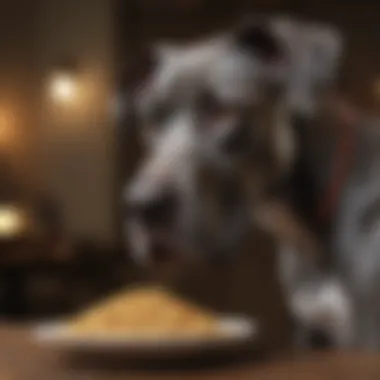Essential Guide to Great Dane Feeding Requirements


Intro
Great Danes are known for their impressive size and unique characteristics. As a Great Dane owner, understanding their feeding requirements is crucial. Their diet significantly affects their growth, health, and overall well-being. This section will discuss various aspects of Great Dane nutrition, focusing on the right food types, appropriate portion sizes, and suitable feeding schedules.
Animal Overview
Common Name and Scientific Classification
The Great Dane, scientifically known as Canis lupus familiaris, belongs to the canine family. This breed originated in Germany and is primarily known for its large stature and gentle temperament. They were originally bred to hunt boars and guard estates.
Physical Characteristics
Great Danes are characterized by their towering height, often reaching between 28 to 34 inches at the shoulder. They typically weigh between 110 to 175 pounds. Their coat can come in various colors, including fawn, brindle, blue, and harlequin. With a strong and muscular build, they possess a confident demeanor, making them both nobles and loyal companions.
Habitat and Distribution
While Great Danes are adaptable and thrive in various settings, they flourish best in homes with ample space. Initially bred in Europe, they are now a popular choice in many parts of the world. Families often seek out this breed due to their friendly nature and suitability as family pets.
Understanding Great Dane Nutritional Needs
Feeding a Great Dane is more than just providing food; it is about meeting their unique nutritional requirements. Large breeds like Great Danes have specific dietary considerations, including the need for nutrients that support healthy bones and joints.
Ideal Food Types
Unleashing the best diet for Great Danes requires considering their age, size, and activity level. A balanced diet should include:
- High-quality protein: Choose dog foods that list meat as the first ingredient, such as beef, chicken, or fish.
- Healthy fats: Omega-3 and omega-6 fatty acids support skin health and promote a shiny coat.
- Carbohydrates: Whole grains, fruits, and vegetables provide necessary energy and fiber.
Portion Sizes
Portion sizes for Great Danes can differ based on age and activity. Generally, adult Great Danes require about 4 to 8 cups of high-quality dry food per day, divided into two meals. Puppies need more calories due to their rapid growth, so it is essential to follow feeding guidelines based on life stages.
Feeding Schedule
Establishing a consistent feeding schedule is important for Great Danes.
- Puppies: Typically require three to four meals a day.
- Adults: Generally thrive on two meals per day.
Keeping a routine helps manage their digestive health and avoid bloating, a concern for large breed dogs.
"Feeding a Great Dane properly is vital for their health, including managing risks associated with their size."
Common Misconceptions About Great Dane Diets
There are several myths regarding Great Dane feeding habits. It is a misconception that these dogs can eat whatever they want due to their size. In reality, feeding them poorly can lead to severe health issues, including obesity and skeletal problems. Understanding correct nutritional practices is key to their health management.
Adhering to these guidelines ensures that Great Danes receive a diet that supports their unique needs, fostering a longer and healthier life. Owners should remain informed and observant of their dogs, seeking guidance from veterinarians whenever necessary.
Prelims to Great Dane Nutrition
Understanding the nutritional requirements of Great Danes is essential for their health and longevity. This breed is known for its remarkable size and unique characteristics, which necessitate specific dietary needs. Proper nutrition plays a vital role in maintaining their physical condition and overall wellness.
Understanding the Breed
Great Danes are one of the largest dog breeds, often referred to as gentle giants. Their size poses distinct health challenges. Their growth rate is rapid, especially during puppyhood, which can lead to nutritional deficiencies if not managed correctly. Therefore, understanding their physiology is key to ensuring their dietary requirements are met. Their large frame requires ample nutrients to support muscle, bone, and joint development.
Importance of Proper Nutrition


The significance of proper nutrition for Great Danes cannot be overstated. A well-balanced diet not only helps in maintaining optimal body weight but also reduces the risk of various health problems including hip dysplasia and bloat, conditions frequently seen in this breed. Moreover, macronutrients and micronutrients affect a Great Dane's energy levels, immunity, and coat health.
Regular consultations with veterinarians can provide personalized dietary recommendations, adjusting for age, activity level, and specific health conditions. This commitment to nutrition ensures that these magnificent dogs lead healthy, happy lives. Consideration of their unique dietary needs forms the cornerstone of responsible Great Dane ownership.
Nutritional Needs of Great Danes
The nutritional needs of Great Danes are crucial for their overall health and well-being. This breed is known for its large size, which directly influences its dietary requirements. Proper nutrition plays a key role in maintaining their body condition, energy levels, and longevity. Owners must be aware of specific elements like portion sizes, food types, and feeding schedules. Understanding these needs helps prevent health issues such as obesity or skeletal problems.
Key Nutrients
Proteins
Proteins are essential for Great Danes as they support muscle development and repair. A high-quality protein source facilitates optimal growth, especially in puppies. Proteins contain amino acids, which are vital for body functions. A beneficial aspect of proteins in Great Dane diets is their role in maintaining a healthy coat and skin. However, not all proteins are equal; selecting the right sources, such as chicken or beef, is important to ensure digestibility.
Fats
Fats provide energy and support various bodily functions, making them an important nutrient for Great Danes. They are a calorie-dense source that can help maintain a healthy weight in active dogs. Fats also contribute to skin and coat health. The unique feature of fats lies in their ability to enhance palatability, making meals more appealing to picky eaters. While beneficial, it is crucial to balance fat intake as excessive fat can lead to obesity.
Carbohydrates
Carbohydrates serve as a quick energy source for active Great Danes. They can also promote healthy digestion when sourced from whole grains or vegetables. A key characteristic of carbohydrates is their ability to provide fiber, which aids in gut health. However, some owners may prefer lower carbohydrate diets to control weight. It is important to choose high-quality carbohydrates, avoiding fillers that offer little nutritional value.
Vitamins and Minerals
Vitamins and minerals are vital to support overall health and prevention of diseases. They help with immune function, bone structure, and energy metabolism. A beneficial choice in formulating a diet for Great Danes is ensuring they receive a balanced mix of both. Vitamins such as A, D, E, and the B complex are particularly important. However, over-supplementation can occur; thus, it is best to consult with a veterinarian to determine essential needs for individual dogs.
Caloric Intake Considerations
Caloric intake for Great Danes must align with their age, size, and activity levels. Puppies require more calories than adult dogs due to their growth rate. Conversely, senior Great Danes may need fewer calories to avoid unnecessary weight gain. Monitoring weight regularly and adjusting the diet as needed is essential. The challenge lies in understanding how to balance calories without compromising nutritional quality. Owners should aim for well-rounded meals that offer both sufficient calories and essential nutrients.
Types of Dog Food for Great Danes
Understanding the right types of dog food for Great Danes is crucial for their overall health and well-being. As a giant breed, Great Danes require specific nutrients in their diet to support their size and growth. Selecting the appropriate type of food ensures that they get a well-rounded nutritional profile tailored for their unique needs.
Dry Kibble vs.
Wet Food
When considering dog food, two primary forms stand out: dry kibble and wet food. Each type has its advantages and disadvantages, and the choice often depends on the individual dog's preferences and needs.
Dry kibble is typically more convenient. It can be stored easily and has a longer shelf life. Additionally, the crunchiness of kibble helps in maintaining dental health by reducing tartar buildup. However, one must ensure that the kibble is of high quality. Look for brands that use real meat as the first ingredient and avoid those loaded with fillers.
In contrast, wet food can offer more moisture, helping in hydration, especially for dogs that may not drink enough water. It often contains more protein and fewer carbohydrates, which can be beneficial for some Great Danes. Nonetheless, wet food can be rancid quickly and usually has a higher cost associated with it. Many owners opt for a mixture of both kibble and wet food for a balanced diet.
Raw Diet Options
The raw diet is becoming increasingly popular among dog owners, including those with Great Danes. This feeding method emphasizes raw meats, bones, fruits, and vegetables. Proponents of this diet argue that it mirrors the dog's ancestral eating habits, potentially leading to better digestion, healthier skin, and shinier coats.
When exploring a raw diet, it is vital to consider the following aspects:
- Balanced nutrition: A balanced diet is essential if you choose this route. It requires careful planning to ensure your Great Dane receives all necessary nutrients.
- Quality sourcing: The quality of ingredients matters. Always source high-quality meats from reputable suppliers to prevent any health risks.
- Bone safety: While raw bones can be great for dental health, they must be appropriate for the dog's size to avoid choking hazards.
- Consult a vet: It is wise to consult with a veterinarian before making significant dietary changes to ensure the diet meets the dog's health needs.
Homemade Diet Considerations
Cooking for your Great Dane can be a rewarding experience, but it also comes with challenges. A homemade diet allows owners to control the quality of ingredients while focusing on the dog's specific dietary requirements.
Here are important factors when considering a homemade diet:
- Nutritional Balance: Ensure that the diet is balanced. Include proteins, carbohydrates, fats, vitamins, and minerals. Consulting with a pet nutritionist can help achieve this balance.
- Ingredient Awareness: Avoid toxic ingredients that are harmful to dogs, such as onions, garlic, or chocolate. Always verify any new additions to the diet.
- Food Safety: Be mindful of food handling practices. Contaminants can harm your pet's health, just as they would for humans.
- Adaptability: As Great Danes age or encounter health issues, their dietary needs may change. Stay informed about how to adapt their meals accordingly, ensuring they receive proper nutrients.


Feeding Great Danes appropriately requires careful thought around the type of food chosen. Whether dry kibble, wet food, a raw diet, or a homemade approach is selected, the primary goal remains: optimal health for these majestic dogs. Remember that individual preferences and health conditions will dictate the ideal feeding solution.
Final Note: Always monitor your Great Dane's response to any dietary changes to ensure their needs are met effectively.
Feeding Schedule for Great Danes
A well-structured feeding schedule is crucial for maintaining the health and proper development of Great Danes. These dogs, known for their large size and unique physiology, require a feeding routine that aligns with their nutritional needs. A regular schedule helps regulate their metabolism, manage their energy levels, and contribute to overall well-being. Establishing and adhering to a proper feeding schedule can prevent potential feeding issues and promote a longer, healthier life for your Great Dane.
Frequency of Feeding
Feeding frequency is an essential aspect of a Great Dane's dietary management. Generally, adult Great Danes benefit from two meals per day. This schedule aids in digestion and helps keep their energy levels stable throughout the day. Puppies, on the other hand, should be fed three to four times daily due to their higher metabolic rate and growing needs.
When considering feeding frequency, the following factors should be taken into account:
- Age: Younger dogs need more frequent feeding to support their rapid growth.
- Activity Level: A more active dog may require additional food in relation to its energy expenditure.
- Health Conditions: Certain medical conditions may necessitate more regular feeding.
Establishing a consistent feeding routine helps manage hunger and can reduce the likelihood of overeating, which often leads to obesity.
Portion Sizes
Determining the right portion size for a Great Dane is vital to ensure they receive balanced nutrition without overindulgence. The recommended portion size mainly depends on the dog’s age, weight, and activity level. For adult Great Danes, the average recommendation is typically between 8 to 10 cups of high-quality dog food per day, divided into two meals.
Guidelines for portion sizes include:
- Monitor Weight: Regularly assess your dog's weight to adjust portions as needed.
- Energy Requirements: Active dogs may require larger portions compared to sedentary dogs.
- Food Type: Different brands and types of food have varying calorie concentrations. Always check the feeding guidelines on the dog food packaging.
A good practice is to consult with your veterinarian to determine the appropriate portion size tailored to your Great Dane’s specific needs.
Proper feeding schedules and portion sizes are crucial for avoiding obesity and ensuring your Great Dane remains healthy.
By managing feeding frequency and portion sizes, Great Dane owners can help ensure that their pets maintain a balanced diet and healthy lifestyle.
Potential Feeding Issues
Feeding Great Danes comes with certain risks that all owners should understand to keep their pets healthy. Addressing potential feeding issues is vital to ensure these gentle giants maintain optimal health. Great Danes are susceptible to specific dietary challenges due to their size and physiology. Thus, focusing on these potential problems can prevent serious health complications, making it essential for all Great Dane owners to be aware.
Bloat and its Prevention
Bloat, also known as gastric torsion or GDV (gastric dilatation-volvulus), is one of the most dangerous conditions affecting Great Danes. This issue occurs when the stomach fills with gas and twists upon itself, leading to a life-threatening situation. Understanding the causes and prevention strategies for bloat can save your dog's life.
Several factors contribute to the occurrence of bloat in Great Danes:
- Eating habits: Rapid eating can lead to swallowing air, increasing the risk of bloat.
- Dietary choices: The type of food being served can play a role. Foods high in carbohydrates or low in quality may worsen the situation.
- Age and size: Older dogs and larger breeds are at higher risk.
- Stress: Anxiety and stress can trigger bloat.
To reduce the risks of bloat, consider the following preventive measures:
- Slow feed bowls: Using a bowl designed to slow down eating can help.
- Frequent small meals: Rather than feeding one or two large meals a day, split the daily intake into smaller portions.
- Post-meal rest: Do not allow vigorous exercise right after eating.
- Monitor stress levels: Provide a calm environment to reduce anxiety during meal times.
"Preventing bloat starts with understanding your dog's eating habits and making necessary adjustments to their diet and routine."
Weight Management
Maintaining a healthy weight is crucial for Great Danes. They are prone to obesity, which can lead to various health issues, including joint problems, diabetes, and heart disease. Thus, it is important to monitor their diets closely and adjust feeding routines based on their age, activity levels, and health.
Here are some strategies for effective weight management:
- Calculate caloric needs: Use guidelines from your veterinarian to determine how much food your dog requires daily.
- Choose quality food: Opt for dog food formulas specially crafted for large breeds, ensuring they contain appropriate nutrients without excessive calories.
- Regular exercise: Encourage daily physical activity to help maintain a healthy weight. Walks, playtime, and mental stimulation are vital for keeping Great Danes active.
- Monitor treats: Limit the number of treats given and choose healthy options.


In summary, addressing potential feeding issues such as bloat and weight management is critical for Great Dane owners. By taking these concerns seriously, you can significantly contribute to your dog's long-term health and well-being.
Senior Great Danes: Adjusting Their Diet
As Great Danes age, their dietary needs undergo significant changes. It is crucial to understand these adjustments to ensure their health and quality of life. Aging can bring about challenges such as weight gain, decreased mobility, and various health conditions. Therefore, modifying their diet accordingly allows owners to avoid certain pitfalls and promote healthier aging.
Changing Nutritional Needs
The transition from adulthood to senior status typically occurs around the age of six years in Great Danes. As they enter this stage, their metabolism tends to slow down. This reduced energy requirement means that their diet must be adjusted.
Key aspects to consider include:
- Lower Caloric Intake: Senior Great Danes require fewer calories to maintain their weight. Weight management becomes critical during these years.
- Increased Fiber: A higher fiber content in their diet promotes healthy digestion, which can often slow down with age.
- Balanced Nutrients: The balance of proteins, fats, and carbohydrates should be tailored to support their aging bodies without stressing their system.
An ideal diet may include high-quality proteins that help maintain muscle mass and support joints. Such nutritional shifts can improve their vitality and comfort.
Health Considerations
A proper diet for senior Great Danes also involves awareness of health issues that may arise. Common conditions include arthritis, digestive issues, and heart problems. Proper nutrition can play a vital role in mitigating these concerns.
Important considerations are:
- Joint Health: Incorporating ingredients like glucosamine and omega fatty acids can support joint function and reduce inflammation.
- Weight Control: Ensuring a healthy weight is essential to avoid stress on joints and other organs. Regular monitoring is necessary, along with adjusting portion sizes.
- Digestive Health: Easier to digest foods can help manage gastrointestinal sensitivities that often develop with age.
Proper diet adjustments can greatly improve the quality of life for senior Great Danes, enhancing their well-being and longevity.
In summary, understanding and adapting the diet of senior Great Danes is essential. Their changing nutritional needs and health considerations must guide owners in providing the most appropriate feeding regimen. Doing so ensures these gentle giants lead happy and healthy lives in their golden years.
Addressing Common Misconceptions
Misunderstandings can significantly affect the health of Great Danes. In this section, we will explore various myths and facts regarding their feeding requirements. It is essential to address these misconceptions not only to promote accurate information but also to support the well-being of these gentle giants.
Myths About Great Dane Feeding
There are several myths surrounding the feeding of Great Danes. Some pet owners may believe that once these dogs reach adulthood, they can be fed adult dog food without consideration for their size and lifestyle. This is not true. The feeding regimen must continue to be tailored to the individual dog's needs throughout life.
Another common myth is that Great Danes do not have special dietary needs due to their size. In fact, their nutritional requirements are unique. High calories and specific nutrient profiles are essential for their joint and overall health. Ignoring these needs can lead to developmental problems or obesity.
Also, some believe that because Great Danes naturally have large appetites, all they require is large quantities of food. This misconception can lead to overfeeding, which can cause health issues, such as bloat or excess weight.
Facts That Matter
It is critical to separate fact from fiction when it comes to feeding Great Danes. Here are some supporting points:
- Great Danes thrive on a specific balance of nutrients currently recommended for large breeds. This includes a higher protein ratio and controlled fat content to prevent obesity.
- Portion sizes should be based on their age, weight, and activity level. Calculating these factors can help ensure a healthy weight while meeting energy needs.
- Feeding frequency for puppies should be more than for adults. Young dogs need to consume meals multiple times a day as their bodies are in critical growth phases.
- The type of food also plays a significant role. High-quality kibble formulated for large breeds will typically have a balanced nutrient content. Some owners may prefer raw or homemade diets, but ensuring balanced nutrition is crucial in those cases as well.
It's important to base the feeding approach on research and veterinary advice, as these pets have specific needs that, if ignored, could lead to serious health concerns.
In summary, dispelling myths and understanding the facts about Great Dane nutrition is vital. This knowledge not only aids in optimal growth and health but also empowers owners to make better feeding choices. Having a well-informed approach can ensure these mighty dogs lead long and healthy lives, free from common avoidable health issues.
Finales on Great Dane Dietary Management
Understanding concluding considerations in Great Dane dietary management is essential for owners and enthusiasts alike. This section summarizes key insights gathered throughout the article while reinforcing the significance of informed feeding practices for these remarkable dogs.
Recap of Key Points
- Nutritional Needs: Great Danes have unique dietary requirements, needing the right balance of proteins, fats, carbohydrates, vitamins, and minerals.
- Feeding Schedule: A regular feeding schedule with proper portion sizes helps maintain their health and prevents overeating or bloat.
- Common Misconceptions: It's vital to distinguish between myths and facts regarding Great Dane nutrition to ensure these dogs receive the best care.
- Senior Dietary Considerations: Older Great Danes have different nutritional needs; adjusting their diet is paramount for their well-being.
Proper understanding of these elements is critical for maintaining the health and longevity of Great Danes.
Final Recommendations
- Quality Food Choices: Choose high-quality dog food designed for large breeds. Look for brands like Royal Canin or Blue Buffalo.
- Monitor Weight: Keep a close eye on their weight. Regular vet check-ups can help ensure they maintain an ideal weight.
- Adjust Portions Accordingly: Based on activity levels, tailor their food portions to avoid overfeeding.
- Stay Informed: Continually educate yourself about your dog's changing dietary needs, especially as they age.
- Consult a Veterinarian: Establish a partnership with a veterinarian knowledgeable about large breeds to get tailored advice.
By adhering to these recommendations, Great Dane owners can ensure their dogs thrive, enjoying a healthy and balanced diet. This knowledge helps prevent various health issues common within the breed, promoting a longer, happier life.







